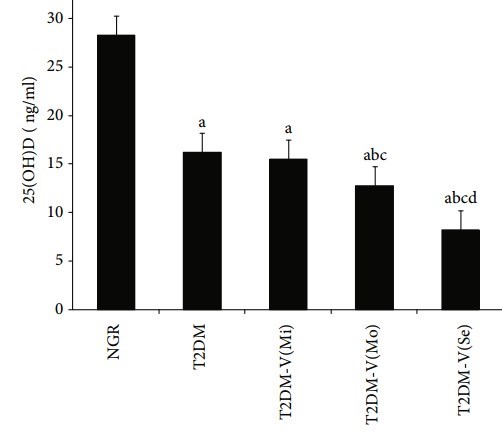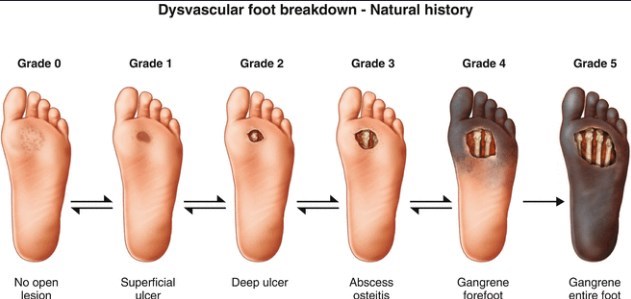The worse the diabetic foot, the lower the vitamin D level
Correlation Analysis between Serum Vitamin D Levels and Lower Extremity Macrovascular Complications in Individuals with Type 2 Diabetes Mellitus
Journal of Diabetes Research, Volume 2019, Article ID 4251829, https://doi.org/10.1155/2019/4251829

NGR: normal glucose regulation; T2DM: Mi: = mild; Mo = moderate; Se = severe

📄 Download the PDF from VitaminDWiki
Mengxue Yang yangmengx123@163.com,1,2 Jun Liu,1 Xue Zhou,2 Heyuan Ding,1 Jie Xu,3 Bo Yang,2 Bowen Sun,2 Dandan Xiao,2 Jie Yu,3 and Qihai Gong4
1Department of Endocrinology, The Fifth People’s Hospital of Shanghai, Fudan University, Shanghai 200240, China
2Department of Endocrinology, Zunyi Medical University, Zunyi 563000, China
3School of Public Health, Zunyi Medical University, Zunyi 563000, China
4Key Laboratory of Basic Pharmacology of Ministry of Education and Joint International Research Laboratory of Ethnomedicine of Ministry of Education, Zunyi Medical University, Zunyi 563000, China
The correlation between serum 25-hydroxy vitamin D (25(OH)D) levels and lower extremity atherosclerotic disease and the predictive value of 25(OH)D for early-stage lower extremity atherosclerotic disease in patients with type 2 diabetes mellitus (T2DM) were explored. In total, 620 subjects (590 T2DM patients and 30 healthy subjects) completed a questionnaire. All subjects were divided into four groups according to serum 25(OH)D concentration quartile: Q1 (<12.18 ng/ml), Q2 (12.18~20.65 ng/ml), Q3 (20.65~31.97 ng/ml), and Q4 (>31.97 ng/ml). Participants were also divided into four groups based on the degree of lower extremity arteriostenosis:
A1 (T2DM),
A2 (T2DM with mild lower extremity vascular lesions (LEVL)),
A3 (T2DM with moderate LEVL), and
A4 (T2DM with severe LEVL).
The incidence of lower extremity artery plaque was significantly higher in groups Q1 and Q2 than in group Q4 (both p <.0.05 ). The concentration of 25(OH)D was significantly lower in group A4 than in groups A1 and A2. Pearson correlation analysis revealed that the degree of lower extremity vascular stenosis was positively correlated with age, smoking, and HbA1c, CRP, and LDL-C levels and negatively correlated with 25(OH)D concentrations. Logistic regression analysis demonstrated that 25(OH)D concentrations exerted a protective effect against LEVL in T2DM patients. Serum 25(OH)D concentrations may be correlated with the incidence of macrovascular disease in T2DM patients. A low serum 25(OH)D concentration is an independent risk factor for lower extremity vascular pathological changes and acts as a prognostic index for lower extremity atherosclerotic disease.
